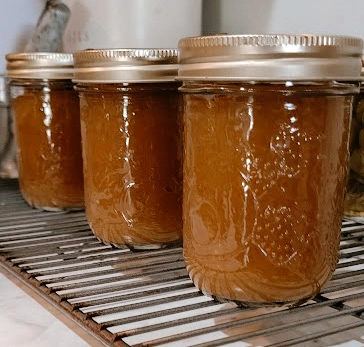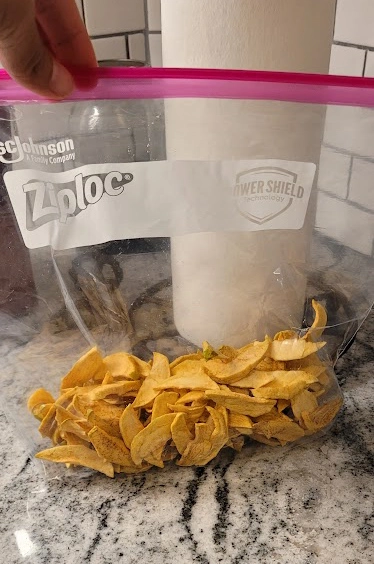Fall is the perfect time to indulge in the fruitful harvest of the season. When I think of fall, I often picture the pioneer times when the community would come together and celebrate the fruits of their labor. County fairs and festivals bring people together to celebrate the season. With harvesting comes the opportunity to practice food preservation.
In this article, we delve into two delightful ways to make the most of the fall harvest: crafting a wholesome snack with dehydrated apple chips and savoring the velvety richness of homemade apple butter. These endeavors not only celebrate the flavors of autumn but also offer a reward in our journey of self-sustainability. Here at Everest, we are passionate about reconnecting to nature, our food, and self-sufficiency, and we find the most gratification in the processes of the journey.
Table of Contents
Dehydrating
Dehydration is a simple, practical way of food preservation. This technique allows individuals to preserve the flavors of peak-season fruits and vegetables, allowing them to be enjoyed year-round. The process of dehydrating food is to remove the water content from food through drying. The drying of the food impedes the growth of bacteria, mold, or yeast. Food items can be eaten dehydrated or rehydrated and used later. Dehydrated food will store and keep for 4 to 12 months. Many factors go into how long they are able to be kept, and it mostly depends on the environmental circumstances.

Always store your dehydrated food in airtight containers. Be sure your storage areas avoid sunlight, heat, and moisture. Most pantries or kitchen cabinets will do the job! Also, a functional way to make use of that unused space above cabinets. I often like to think back to old vintage kitchens; everything was functional, and spaced was used. Overall dehydrated foods require minimal energy for storage, and their carbon footprint is considerably smaller compared to canning or freezing. Additionally, dehydrating minimizes the need for single-use plastic packaging, making it a planet-friendly choice.
Embracing food dehydration as a preservation method invites creativity into the kitchen, inspiring homemade granolas, trail mixes, and flavorful seasonings. With its positive impact on food waste, nutrition, and the environment, food dehydration emerges not only as a preservation technique but as a mindful step towards a healthier, greener future.
Delectable Dehydrated Apple Chips
Now, let’s take these whole apples and transform them into a delectable snack. Discover how to transform a bushel of apples into a crunchy, guilt-free snack that’s perfect for lunchboxes, hiking trips, or just cozy evenings by the fireplace. My family has an apple tree we planted on our 55-acre Oklahoma farm years ago. I always enjoy watching the apples grow, harvesting them, preserving them, and enjoying the lovely treats we create. Dehydrated apples can be eaten as a snack or rehydrated later to make applesauce and several baked goods such as pies, cobblers, and crisps.
Apple Chips
Ingredients:
- Apples (preferably tart)
- Fruit Fresh or Lemon Juice
- Cinnamon Sugar topping (optional)
STEP 1: Wash, Peel, and Core Apples
STEP 2: Slice Apple into ¼- ½ inch rings or half slices.
STEP 3: Pretreat your apples by dipping fresh fruit or lemon juice. If topping with cinnoman sugar lightly sprinkle over trays before drying.
STEP 4: Dry apples at 130- 135 degrees until pliable
STEP 5: Let the apple cool completely and store it in an airtight container.
NOTE: The third step to pretreat is to prevent the fruit from browning. If using lemon juice, mix ¼ cup of lemon juice with 4 cups of water. Fruit fresh is basically a refined form of lemon juice. Fruit Fresh does not contain lemon oil, so if you are sensitive to the lemon flavor, I suggest fruit fresh. It can be found in the canning aisle.
Homemade Apple Butter
Apple Butter is a timeless delight. Canning apple butter has become a cherished tradition that takes the flavors of fall and preserves them in velvety, spreadable form. Apple Butter can be used as a topping for toast and biscuits as well as a sandwich spread.
Ingredients:
- 4- 5 pounds of Apples
- 2 cups Brown sugar
- 2 cups White sugar
- 2 tsp Cinnamon
- 2 cups water
STEP 1: Wash, Peel, and Core apples.
STEP 2: Cut Apples into quarters.
STEP 3: CROCKPOT or STOVETOP
- CROCKPOT: Combine all the ingredients. Cook on low for 10 hours, occasionally stirring, until the mixture is dark brown and has thickened. Use a blender or an immersion blender to puree the apple butter until smooth.
- STOVETOP: Combine apples and water. Cook at a simmer until soft. Use a blender or an immersion blender to puree the apples until smooth. Add in sugar and spices, and continue stirring until sugar is dissolved. Cook on a simmer until the mixture is thick enough to mound on a spoon. If the mixture becomes too thick, add water as needed. Stir frequently to prevent burning.
STEP 4: SHORT TERM STORAGE: Ladle the mixture into sterile containers, cover, and refrigerate for up to two weeks or freeze for up to 4 months.
CANNING: Ladle hot butter into warm jars, leaving ¼ inch head space. Use your canning poker tool to remove any air bubbles. Use a clean towel dipped in vinegar to clean the rims. Place new flats on the top and finger-tighten the bands. When ready, place the jars onto the canning rack of the water bath canner. Lower the rack into simmering water. Water must cover the jars by 1 inch. Process jars for 10 minutes. After the processing time has passed, remove the lid and turn off the heat. Allow the canner to cool for 5 minutes. Remove jars from the canner, do NOT touch lids or retighten bands. Cool for 12-24 hours. Check seals if any did not seal reprocess or place in the fridge for immediate use. Properly sealed jars will keep for 12 months.
STEP 5: Label and store
Enjoy the Taste of Fall
With the fall harvest’s bounty at your fingertips, there’s no better time to embrace the art of preservation. Dehydrating apple chips and crafting homemade apple butter offer not only a delicious connection to the season but also an avenue for sustainable living.
As you embark on these culinary adventures, you’ll savor the flavors of autumn and experience the satisfaction of transforming nature’s gifts into delectable delights that will warm your heart and palate long after the leaves have fallen.
In a world where food waste and sustainability are growing concerns, the practice of food dehydration and canning provides a versatile and efficient method of preservation.











